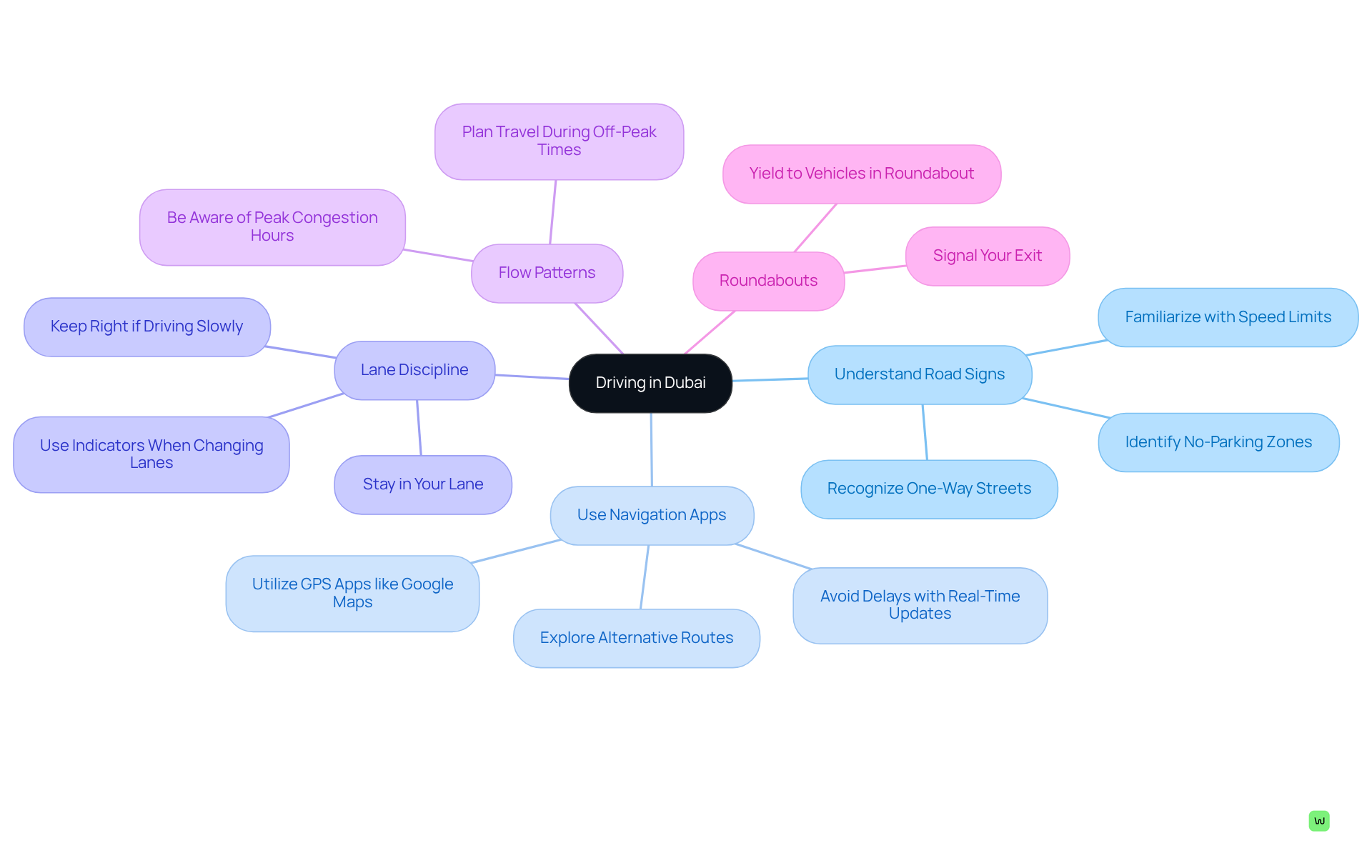Overview
This article presents five essential steps for driving safely and confidently in Dubai. It emphasizes the importance of:
- Understanding local driving laws
- Obtaining the necessary permits
- Navigating the roadways
- Renting luxury cars
- Troubleshooting common driving challenges
Each step is underpinned by specific regulations, practical tips, and strategies designed to enhance your driving experience while ensuring compliance with local laws. By following these guidelines, you will foster a safer and more enjoyable journey throughout the city.
Introduction
Driving in Dubai presents an exhilarating experience, yet it is accompanied by unique challenges and regulations that every driver must navigate. Are you prepared to understand local traffic laws and obtain the necessary permits? Mastering the intricate roadways and traffic patterns is essential for a smooth journey. What occurs when the thrill of driving intersects with the complexities of unfamiliar regulations and heavy congestion? This guide outlines essential steps to ensure that every trip is not only safe but also confident, allowing you to make the most of the vibrant roads in this dynamic city.
Understand Local Driving Laws and Regulations
Before you drive in Dubai, it is crucial to familiarize yourself with local traffic laws and regulations to ensure a safe and enjoyable journey. Consider these key points:
-
Speed Limits: In urban areas, speed limits typically range from 60 to 80 km/h, while on highways, they increase to between 100 and 120 km/h. Exceeding these limits can lead to significant fines, with penalties for speeding over 60 km/h reaching AED 3,000 and potential vehicle confiscation.
-
Seat Belts: The law mandates that all passengers wear seat belts. Non-compliance can lead to fines of AED 400 and four black points on your record.
-
Mobile Phone Use: Using a mobile phone while operating a vehicle is strictly prohibited unless you are using a hands-free device. Violators face fines of AED 800 and four black points.
-
Alcohol Consumption: Dubai enforces a zero-tolerance policy regarding drinking and driving, with a legal blood alcohol limit set at 0.0%. Offenders can face severe penalties, including arrest and heavy fines.
-
Road Signals: Following road signals and signs is essential. Running a red light can incur fines up to AED 50,000 and result in black points, emphasizing the importance of compliance with traffic regulations.
By understanding these regulations, you can drive in Dubai confidently and avoid unwarranted penalties, ensuring a pleasant trip through this vibrant metropolis.

Obtain the Required Driving Permit
To operate a vehicle legally in Dubai, acquiring the appropriate permit is essential. Here’s how you can ensure compliance:
For Residents: If you are a resident, obtaining a UAE license is mandatory to operate a vehicle. To secure one, follow these steps:
- Enroll in an RTA-approved driving school.
- Complete the required theoretical and practical training.
- Pass both the theory and road tests.
- Submit necessary documents, including your Emirates ID, passport, and a medical fitness certificate.
For Tourists: If you are visiting the city, you can drive with an international driving permit (IDP) alongside your valid home country license. Ensure that:
- Your IDP is recognized in the UAE.
- You carry your passport and visa while driving.
By adhering to these guidelines, you can confidently ensure that you are legally permitted to drive in Dubai.

Navigate Dubai's Roadways and Traffic Patterns
Driving in Dubai's highways presents challenges due to heavy congestion and complex transportation systems. To enhance your driving experience, consider the following essential tips:
- Understand Road Signs: Familiarize yourself with local road signs, including speed limits, no-parking zones, and one-way streets. This knowledge is crucial for compliance and safety.
- Use Navigation Apps: Utilize GPS navigation applications such as Google Maps or Waze to find the best routes and avoid delays. These apps provide real-time congestion updates and alternative paths.
- Lane Discipline: Always stay in your lane and use indicators when changing lanes. The left lane is primarily for overtaking, so keep to the right if you are driving at a slower speed.
- Flow Patterns: Be aware of peak congestion hours, typically during morning and evening commutes. Planning your travel during off-peak times can save you time and reduce stress.
- Roundabouts: Yield to vehicles already in the roundabout and signal your exit. This practice helps maintain a smooth flow of traffic.
By mastering these navigation tips, you can drive in Dubai with greater confidence and safety in the city.

Rent a Luxury Car for an Enhanced Experience
Renting a luxury vehicle to drive in Dubai can significantly enhance your travel experience. Here’s how to navigate the process effectively:
- Choose a Reputable Rental Company: Opt for established luxury car rental services like WheelsOn, recognized for their diverse fleet of high-end vehicles and exceptional customer support, available 24/7 to assist you with any inquiries or issues.
- Select Your Vehicle Wisely: Assess your requirements, including passenger capacity and luggage space. Popular choices range from high-performance sports cars to spacious SUVs and elegant sedans, all equipped with plush leather seats and advanced safety features for your comfort and security.
- Review Rental Terms Thoroughly: Scrutinize the rental agreement, focusing on mileage limits, insurance coverage, and fuel policies. Transparency is key, so ensure there are no hidden fees, as this is crucial for a hassle-free experience.
- Book in Advance: To secure your preferred vehicle, especially during peak tourist seasons, make your reservation ahead of time through the rental company’s website or user-friendly app. This flexibility in rental durations allows you to choose the best option for your travel needs.
- Inspect the Vehicle Before Departure: Conduct a thorough inspection of the car for any pre-existing damage and verify that all features are operational. Document any issues to prevent disputes later.
By following these steps, you can guarantee a lavish and unforgettable drive in Dubai, enhancing your overall travel enjoyment. As one satisfied customer noted, "Renting from WheelsOn transformed my trip into an unforgettable experience.

Troubleshoot Common Driving Challenges
To drive in Dubai presents various challenges that require effective navigation strategies. Consider these common issues and how to address them:
-
Heavy Traffic: Limited road capacity, particularly during peak hours, leads to significant traffic congestion. In 2025, statistics indicate that residents of Dubai and Sharjah experience considerable delays, with travel times extending by up to 40% in areas like Dubai Production City and Jumeirah Village Circle. To manage dense traffic, remain calm and patient. Leverage reliable navigation apps such as Google Maps or Waze for real-time traffic updates and alternative routes. Additionally, consider departing earlier to mitigate delays.
-
Road Hazards: Stay alert for potential road hazards, including potholes, construction zones, and sudden lane changes by other drivers. Adhering to the 3-second rule—maintaining a safe following distance of at least 3 seconds—ensures you have adequate reaction time for unexpected situations. Always wear your seatbelt, as it significantly reduces the risk of injury in an accident.
-
Vehicle Issues: Should you encounter mechanical problems, safely pull over and contact your rental company for assistance. Familiarize yourself with the vehicle’s emergency features, including hazard lights and spare tire access, to effectively handle minor issues.
-
Accidents: In the unfortunate event of an accident, prioritize safety. Dial 999 for police, 998 for ambulance, or 997 for fire department if necessary. Exchange information with the other party and document the scene with photos. Notify your rental company for further instructions to ensure proper handling of the situation.
-
Navigational Errors: If you find yourself lost, don’t hesitate to pull over and consult your GPS or a map. Engaging with locals for directions can also provide valuable assistance.
By preparing for these challenges, you can drive in Dubai with confidence and safety.

Conclusion
Driving in Dubai is not merely an exhilarating experience; it demands a thorough understanding of local laws, regulations, and best practices to ensure safety and confidence on the road. By familiarizing yourself with key traffic laws, obtaining the correct driving permits, and mastering navigation techniques, you can significantly enhance your overall experience in this vibrant city.
This article outlines essential steps to facilitate a smooth driving experience in Dubai. Key points include:
- Understanding local traffic laws, such as speed limits and seat belt regulations.
- Ensuring the correct driving permit is obtained.
- Utilizing navigation apps to navigate the bustling roadways.
Additionally, renting a luxury vehicle can elevate your driving experience, while being prepared for common driving challenges will help you maintain safety and composure on the road.
Ultimately, driving in Dubai transcends the simple act of getting from point A to point B; it’s about embracing the journey with confidence and enjoyment. By adhering to the guidelines provided and staying informed about local driving norms, you can create memorable experiences while exploring all that Dubai has to offer. Whether you are a resident or a tourist, taking the time to prepare for driving in this dynamic city ensures a safe and rewarding adventure on its roads.
Frequently Asked Questions
What are the speed limits in Dubai?
In urban areas, speed limits typically range from 60 to 80 km/h, while on highways, they increase to between 100 and 120 km/h.
What are the penalties for exceeding speed limits in Dubai?
Exceeding the speed limit can lead to significant fines, with penalties for speeding over 60 km/h reaching AED 3,000 and potential vehicle confiscation.
Are seat belts mandatory in Dubai?
Yes, the law mandates that all passengers wear seat belts. Non-compliance can result in fines of AED 400 and four black points on your record.
Can I use my mobile phone while driving in Dubai?
Using a mobile phone while operating a vehicle is strictly prohibited unless using a hands-free device. Violators face fines of AED 800 and four black points.
What is Dubai's policy on drinking and driving?
Dubai enforces a zero-tolerance policy regarding drinking and driving, with a legal blood alcohol limit set at 0.0%. Offenders can face severe penalties, including arrest and heavy fines.
What happens if I run a red light in Dubai?
Running a red light can incur fines up to AED 50,000 and result in black points, highlighting the importance of complying with traffic regulations.
What type of driving permit do I need to drive in Dubai?
Residents must obtain a UAE license, while tourists can drive with an international driving permit (IDP) alongside their valid home country license.
What steps must residents follow to obtain a UAE driving license?
Residents must enroll in an RTA-approved driving school, complete the required theoretical and practical training, pass both the theory and road tests, and submit necessary documents including their Emirates ID, passport, and a medical fitness certificate.
What should tourists carry while driving in Dubai?
Tourists should carry their international driving permit (IDP), valid home country license, passport, and visa while driving in Dubai.




